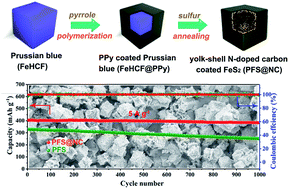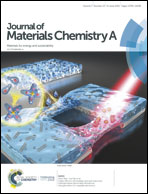Yolk–shell N-doped carbon coated FeS2 nanocages as a high-performance anode for sodium-ion batteries†
Abstract
Pyrite FeS2 displays brilliant prospects for sodium storage because of its high theoretical capacity (894 mA h g−1), low cost and eco-friendly properties. The practical application of FeS2, however, has been thwarted by poor cycle life derived from the large volume change and active sulfide loss upon sodiation/desodiation. Herein, we fabricated yolk–shell nitrogen-doped carbon-coated FeS2 nanocages (PFS@NC) by a facile thermal-sulfurization of polypyrrole-coated Prussian blue precursors for sodium-ion batteries. The yolk–shell structure affords enough space to buffer the volumetric change of FeS2 nanoparticles during the sodiation process. Therefore, the structural integrity of PFS@NC can be preserved without deforming the carbon shell. Additionally, the nitrogen-doped carbon not only improves the electronic conductivity of the composite, but also effectively traps the soluble reduced products of FeS2, contributing to its stable cycling performance. As a result, a high specific capacity of 375 mA h g−1 has been achieved up to 1000 cycles at 5 A g−1 (92% capacity retention). The PFS@NC composite could be an excellent anode material for sodium storage and the as-developed synthetic strategy is expected to be utilized for improving the performance of other metal sulfide electrode materials.



 Please wait while we load your content...
Please wait while we load your content...